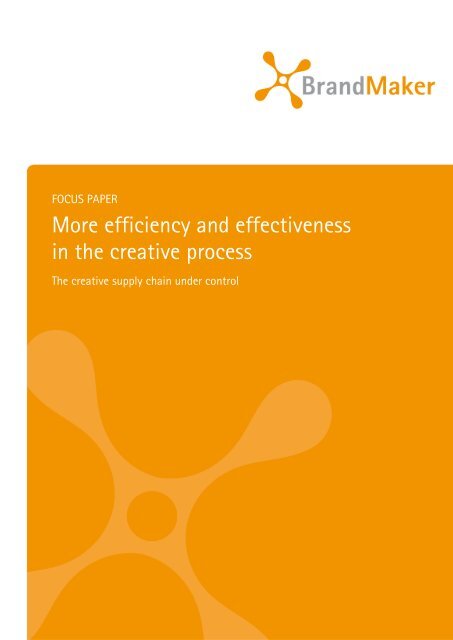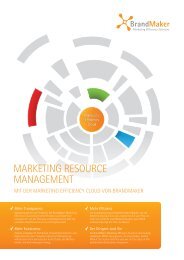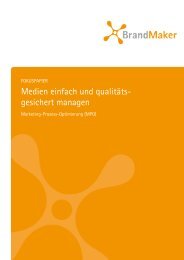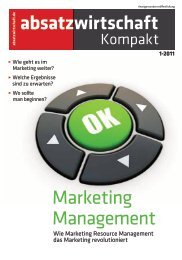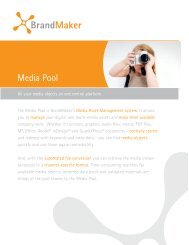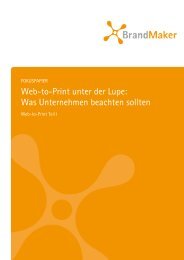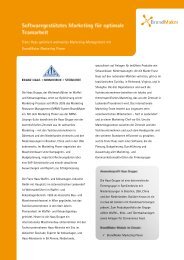Focus Paper Job and Review Management - BrandMaker
Focus Paper Job and Review Management - BrandMaker
Focus Paper Job and Review Management - BrandMaker
Create successful ePaper yourself
Turn your PDF publications into a flip-book with our unique Google optimized e-Paper software.
FOCUS PAPER<br />
More efficiency <strong>and</strong> effectiveness<br />
in the creative process<br />
The creative supply chain under control
FOCUS PAPER The creative supply chain under control<br />
Supply chain management postulates that in the future it will no longer be enterprises, but rather supply<br />
chains, which compete with one another. Because: The fewer interface problems <strong>and</strong> breaches an<br />
enterprise encounters in its processes, the more efficiently <strong>and</strong> effectively can it serve its customers.<br />
In times of comparable products, extremely competitive markets <strong>and</strong> global competition, this is a key<br />
element necessary to survive in the market. But what is the status of the supply chains in marketing <strong>and</strong><br />
communications — the creative supply chains? Are they both efficient <strong>and</strong> effective – i.e. competitive – or<br />
are they more like a ball <strong>and</strong> chain for market communications, in matters of quality, cost, <strong>and</strong> speed? This<br />
focus paper is dedicated to the challenges within the creative supply chain, <strong>and</strong> demonstrates timely<br />
solutions, with the aid of modern IT, which make marketing forceful <strong>and</strong> agile in regard to processes.<br />
Hardly any other corporate field is comparable to marketing in its emphasis on interfaces in its processes. Information,<br />
ideas, concepts, <strong>and</strong> thoughts are exchanged via these interfaces, <strong>and</strong> their conclusion should be of a successful<br />
campaign as the output of the creative process. A particularly critical process in marketing is the creative production<br />
process: There, diverse process participants within <strong>and</strong> outside the enterprise exchange an idea, a concept, <strong>and</strong> its results.<br />
Creation usually takes place under enormous time <strong>and</strong> cost pressure – in the triangle of objectives regarding quality,<br />
costs, <strong>and</strong> time, at least one dimension suffers – <strong>and</strong> so do the nerves of the participants.<br />
Figure: The Creative Supply Chain<br />
Several problems <strong>and</strong> challenges arise for the participants in the course of a process of creation. The most important are<br />
as follows:<br />
- Marketing receives ideas, wishes, or suggestions for campaigns from product management, from the sales <strong>and</strong><br />
distribution department, or directly from the corporate leadership level, <strong>and</strong> in addition generates its own plans.<br />
This input is captured in a variety of forms; sometimes in the form of e-mails; sometimes only orally in informal<br />
© Br<strong>and</strong>Maker GmbH, Mirko Holzer Page | 2
FOCUS PAPER The creative supply chain under control<br />
talk at the coffee machine; sometimes in a regulated process as well. But: Only rarely plans <strong>and</strong> ideas for<br />
creative productions are captured centrally <strong>and</strong> designated as a job. This results in a lack of transparency about<br />
the current workload <strong>and</strong> the “pipeline” of currently existing projects. Thus, not only in marketing itself, but also<br />
on the corporate leadership level, it is elusive exactly what is pending or already underway.<br />
- Once the process of creation is started, the next step involves the selection <strong>and</strong> briefing of the appropriate<br />
service provider – whether an internal production department or an outside agency. Whatever is received as<br />
unclear input unclear here, will not become any clearer in the course of creation; for this reason, a core<br />
challenge in the creative process is the preparation of an exact, complete, <strong>and</strong> timely briefing.<br />
- Briefing is followed by creation <strong>and</strong> the associated coordination processes. In a more or less time-consuming<br />
process going back <strong>and</strong> forth, the desired solution is approached in a step-wise way. Working efficiently <strong>and</strong> the<br />
effective communication of desired changes <strong>and</strong> feedback are a particular challenge. In reality, this process<br />
frequently takes place via e-mail, involving large mailing lists <strong>and</strong> file attachments. It also involves the<br />
conversion of files, so that all participants can take a look at the design: For example, before each review the<br />
layout draft must be converted from a desktop publishing (DTP) program into a PDF or other well-established<br />
format. The result is an abundance of file versions <strong>and</strong> a process that is no longer fully traceable, so that in the<br />
end, sometimes it is not even possible to explain why one has selected one thing over the other.<br />
- In the previous process step, time pressure frequently grows sharply, because coordination takes longer than<br />
anticipated or because a concept must be redesigned in its entirety because there is a new idea or the original<br />
idea is just not realizable. Time pressure frequently results in loss of quality, which in turn leads to the need for<br />
corrections <strong>and</strong> reviews. The real objective is to be able to invest as much as possible of the little time available<br />
into the creative process by minimizing the time spent for reviews, corrections, <strong>and</strong> file transmissions.<br />
- In the review phase, staff easily lose the overview over the current project status, over costs, <strong>and</strong> releases which<br />
have been given or are still pending. The results are errors due to lack of transparency; forgotten releases,<br />
exploding costs, <strong>and</strong> erroneous transmission of documents due to a chaos of versions.<br />
- A further source of error is the lack of st<strong>and</strong>ardization in the course of a project. Even though the content of<br />
each creative project may be different; the workflow sequences may be st<strong>and</strong>ardized to a great extent, at least<br />
as long as media are the same (for example, for all advertisement or for all brochures which are developed). This<br />
is utilized only by a small number of companies which in part is underst<strong>and</strong>able as different employees are<br />
involved in different projects: from an individual point of view, the easiest is for each of them to execute the<br />
project in his/her own way. However, especially in the st<strong>and</strong>ardization of the creative processes there is an<br />
enormous potential for increased efficiency.<br />
© Br<strong>and</strong>Maker GmbH, Mirko Holzer Page | 3
FOCUS PAPER The creative supply chain under control<br />
Increased number of<br />
required reviews <strong>and</strong><br />
corrections<br />
Tough timelines for<br />
creation <strong>and</strong><br />
processing<br />
More errors<br />
Figure: The review cycle in marketing – from “the hundredth to the thous<strong>and</strong>th”<br />
Order<br />
Briefing<br />
<strong>and</strong><br />
Quote<br />
Creation<br />
<strong>Review</strong>s<br />
<strong>and</strong><br />
Feedback<br />
Lack of transparency,<br />
unclear requirements<br />
<strong>and</strong> briefings<br />
The approach to a solution for marketing departments which want to simplify, accelerate, <strong>and</strong> better document their<br />
creative workflows, are st<strong>and</strong>ardized processes, together with the application of a suitable software platform for the<br />
support of those workflows.<br />
As a starting point, the creative production process may be divided into its individual components <strong>and</strong> these components<br />
can be analyzed as to their optimization potentials. This analysis eventually leads to a holistic improvement of the<br />
process:<br />
Figure: Processes involved in a creative production process<br />
Corrections Approval<br />
Pre-<br />
Production<br />
/ Typesetting<br />
Production<br />
Creative processes can be st<strong>and</strong>ardized by dividing them into two components: the framework¸ the scaffold, so to speak,<br />
for the sub-process; <strong>and</strong> its content. The process framework represents the component that may be st<strong>and</strong>ardized: Here<br />
mistakes can be minimized, quality optimized, workflow times speeded up <strong>and</strong> costs reduced. The content-related<br />
component refers to the creative work. Here, effectiveness <strong>and</strong> efficiency largely depends on the persons involved in the<br />
process.<br />
© Br<strong>and</strong>Maker GmbH, Mirko Holzer Page | 4
FOCUS PAPER The creative supply chain under control<br />
Objective of process optimization is to provide a framework to the creative part of the work which provides enough<br />
stability for st<strong>and</strong>ardization <strong>and</strong> at the same enough flexibility to optimally support the execution of creative work <strong>and</strong><br />
to allow that the available resources can be fully focused on the content. This means: minimal frictional losses, <strong>and</strong> total<br />
focusing on the creative core mission of the marketing <strong>and</strong> communication spheres. With the help of specialized<br />
software adapted to marketing <strong>and</strong> creative production this framework can be optimally supported.<br />
A software solution that provides a framework for the execution of creative supply processes in marketing must master<br />
the balancing act between st<strong>and</strong>ardization <strong>and</strong> flexibility. St<strong>and</strong>ardization is required to work efficiently; flexibility is<br />
needed to incorporate the specific aspects of each creative project to the degree necessary.<br />
In the search for suitable software for marketing workflow management, there are several necessary prerequisites:<br />
- Projects, workflows, <strong>and</strong> media must be centrally filed <strong>and</strong> accessible. This is best accomplished via client<br />
server-based software or, even better, web-based software, so that users as well as outside service providers<br />
such as agencies <strong>and</strong> printers can access their projects <strong>and</strong> the media via the Internet from any location.<br />
- The online project platform for the creative supply chain must flexible enough to cover the job contents <strong>and</strong> the<br />
processes specific both to the enterprise <strong>and</strong> to the project. This is the only way to achieve complete project<br />
documentation <strong>and</strong> frictionless workflows, by, for example, providing st<strong>and</strong>ard workflows for each type of<br />
media, so that e.g. print adverts automatically go to the appropriate approver, <strong>and</strong> online banners likewise are<br />
automatically routed to the right contact person in the company.<br />
- The processes shown must of course enable collaboration between the employees working on the project. As<br />
these participants are both internal <strong>and</strong> external users, different access rights <strong>and</strong> project views are<br />
indispensable. Role-based access capabilities meet this requirement.<br />
- The review process must always be of the same simplicity, independent of the file format to be reviewed –<br />
without additional file conversion <strong>and</strong> multiple saving of files. This way, a company saves a great deal of time<br />
on the part of external service providers <strong>and</strong> internally.<br />
But before any advantages of a software solution can take effect, the process must be highlighted <strong>and</strong> analyzed.<br />
Thus, in the following, the st<strong>and</strong>ard creative process is outlined with its essential characteristics. Additional comments<br />
give information as to how a software solution provides support in this step. It should be noted that the concrete<br />
characteristics of an optimal process differ from company to company; depending, for example, on the kind <strong>and</strong> number<br />
of external service providers, or on the organization of the approval processes. The following depiction is intended as an<br />
aid to becoming aware of existing <strong>and</strong> optimal processes in your own company.<br />
© Br<strong>and</strong>Maker GmbH, Mirko Holzer Page | 5
FOCUS PAPER The creative supply chain under control<br />
Process Component What happens in this step? What information is required? Who are the participants? How can software support the process?<br />
New Project<br />
Briefing <strong>and</strong> Quotes<br />
Procurement <strong>and</strong> Creation<br />
<strong>Review</strong> <strong>and</strong> Feedback<br />
Assembly of the briefing for a new<br />
project,<br />
Internal coordination of given<br />
guidelines <strong>and</strong> conditions.<br />
The briefing is transmitted to one or<br />
more of the selected service<br />
providers (internal or external).<br />
This is followed by visual inspection,<br />
clarification of questions, <strong>and</strong> if<br />
necessary, submitting a quote.<br />
The production order is issued <strong>and</strong><br />
the actual creative process begins.<br />
Designs <strong>and</strong> concepts are created,<br />
commented upon, <strong>and</strong> revised.<br />
Challenge: Feedback from various<br />
persons must be consolidated; there<br />
may be contradictions; back <strong>and</strong><br />
forth corrections; time loss.<br />
As much as possible!<br />
Basic information such as timing,<br />
cost parameters, client, type of<br />
media to be created.<br />
Content-related information such<br />
as overall concept, objectives,<br />
channels to be activated, etc.<br />
Available <strong>and</strong> appropriate service<br />
providers <strong>and</strong> their contact data.<br />
Offers <strong>and</strong> costs of various service<br />
providers.<br />
First ideas for realization.<br />
Media designs must exist in a<br />
format which makes it possible for<br />
the client to provide feedback.<br />
Change requests <strong>and</strong> feedback<br />
about the designs.<br />
Media designs in versions 1 to x.<br />
Internal person in charge of<br />
marketing <strong>and</strong> internal client (either<br />
marketing itself or another<br />
department; for example, sales <strong>and</strong><br />
distribution or product management).<br />
Project manager <strong>and</strong> service<br />
providers.<br />
Project managers <strong>and</strong> selected<br />
service providers.<br />
Project managers <strong>and</strong> service<br />
providers.<br />
� Depending on the media, specific web-based data forms can<br />
be provided (for example, advertisements, web banners,<br />
brochures, etc.) which include all required information (for<br />
example, printing parameters for printed media, <strong>and</strong><br />
technical data for online media).<br />
� The completeness of this data can e.g. be defined as<br />
prerequisite for the creation of an order.<br />
� Service providers are stored in the software with their<br />
histories <strong>and</strong> evaluations to support the selection process.<br />
� Automatic transmittal of the complete briefing to selected<br />
service providers, <strong>and</strong> automatic notification of project<br />
managers in case of questions or submission of a quote.<br />
� Assignment of contracts via software only allows selected<br />
service providers continued access to the web-based job<br />
file; the remaining service providers now can no longer view<br />
the job.<br />
� A software solution with a review tool allows viewing of<br />
any file format <strong>and</strong> entry of comments in the form of virtual<br />
sticky notes directly online. The service provider can directly<br />
upload source files without file conversion.<br />
� All participants review the same current media version, <strong>and</strong><br />
the comments of others are transparent <strong>and</strong> traceable.<br />
© Br<strong>and</strong>Maker GmbH, Mirko Holzer Page | 6
FOCUS PAPER The creative supply chain under control<br />
Process Component What happens in this step? What information is required? Who are the participants? How can software support the process?<br />
Corrections<br />
Approval<br />
Pre-Production / Typesetting<br />
Production<br />
The service provider makes required<br />
corrections <strong>and</strong> provides a new<br />
media version.<br />
The client approves the medium for<br />
production.<br />
The released medium is given over<br />
to production preparation or to<br />
typesetting.<br />
<strong>Review</strong>, correction <strong>and</strong> approval<br />
steps follow as described above.<br />
The project may be returned again<br />
for new creation.<br />
The medium is produced <strong>and</strong><br />
delivered to the client.<br />
Cumulative correction requests <strong>and</strong><br />
changes, as well as the media<br />
version with comments.<br />
The new media version.<br />
Final medium, final cost data,<br />
timing.<br />
The final media version, <strong>and</strong> as<br />
necessary, also information on<br />
corrections <strong>and</strong> changes as well as<br />
releases.<br />
Final media version <strong>and</strong> production<br />
approval.<br />
Assigned service providers.<br />
Internal project employees, but also,<br />
for example, technical approval by<br />
project management, or legal<br />
approval by legal department.<br />
The producing service provider <strong>and</strong><br />
the internal project manager from<br />
marketing.<br />
Production service providers.<br />
� Central <strong>and</strong> transparent entrainment of all comments to<br />
each media version allows simple <strong>and</strong> structured<br />
incorporation of changes.<br />
� Updated media versions are provided directly via the<br />
software, <strong>and</strong> replace manual sending via e-mail.<br />
� The required approvals are obtained via the tool. At any<br />
time, the status of missing approvals is visible.<br />
� The software sends automatic reminders <strong>and</strong> information<br />
notices on approvals.<br />
� Automatic notification of the production service providers,<br />
concerning an existing order.<br />
� Correction copies, etc. for release can be provided via the<br />
software.<br />
� Following conclusion of the project, the job folder is closed<br />
<strong>and</strong> archived in the software.<br />
� The performance of the service provider can be assessed.<br />
� Past orders remain traceable <strong>and</strong> transparent.<br />
© Br<strong>and</strong>Maker GmbH, Mirko Holzer Page | 7
FOCUS PAPER The creative supply chain under control<br />
The use of suitable software for the management of creative workflows in marketing supports the realization of potential<br />
savings, higher quality, <strong>and</strong> better timing of creation. The advantages in detail:<br />
- more transparency for the process participants through traceability <strong>and</strong> documentation,<br />
- better evaluation of weak points <strong>and</strong> risks; for example, more accurate estimation in advance of the time<br />
needed for creation up to the delivery of the finished media,<br />
- early recognition <strong>and</strong> solution of bottleneck situations by transparency over the entire volume of jobs,<br />
- faster <strong>and</strong> more structured coordination via st<strong>and</strong>ardized processes, less complexity, <strong>and</strong> up-to-date<br />
information,<br />
- higher quality through complete information,<br />
- flexible job h<strong>and</strong>ling by workflows <strong>and</strong> job files specific to different types of media,<br />
- faster approvals,<br />
- better communication within the team,<br />
- Reduction of administrative costs (file format conversions, e-mail transmission).<br />
Figure: <strong>Job</strong> overview <strong>and</strong> interactive review tool using the example of Br<strong>and</strong>Maker<br />
Software solutions for workflow optimization in the creative supply chain are frequently inseparably connected to media<br />
asset management, a central database for created media objects. This connection is recommended to companies that<br />
© Br<strong>and</strong>Maker GmbH, Mirko Holzer Page | 8
FOCUS PAPER The creative supply chain under control<br />
strive for a complete integration of their creative processes, without media breaks <strong>and</strong> interface losses:<br />
- The media asset management system is the central storage location for all media designs <strong>and</strong> for the final<br />
media.<br />
- It guarantees a transparent <strong>and</strong> correct version control.<br />
- It provides further optimization of the creative processes through a direct connection with the desktop of the<br />
designer allowing the interface-free uploading of data.<br />
- Immediately following release, media are available in the media asset pool for intended users.<br />
The scenario which is described here can be turned around from the point of view of the creative companies involved in<br />
the value chain, because an optimized supply chain, on the basis of appropriate software, also offers increased potential<br />
for these companies. If, for example, an agency or a printing service provider installs a web-based review tool in order to<br />
present its customers media designs <strong>and</strong> correction copies for coordination, correction, <strong>and</strong> approval online via the tool,<br />
the company provides itself with a considerable competitive advantage. For:<br />
- A web-based review tool provides an incomparably comfortable possibility to view <strong>and</strong> comment media for<br />
clients at the company side. No more umpteen megabytes in the in-box, no version chaos, no redundant<br />
feedback on a now-obsolete design. Via web link, the client goes directly to the review tool <strong>and</strong> provides his/her<br />
feedback.<br />
- In addition to perfect customer service, a service provider can gain time for itself <strong>and</strong> its clients, since review<br />
<strong>and</strong> correction cycles are accelerated.<br />
- The service provider also retains the upper h<strong>and</strong> on source data of the designs, if this has been agreed upon with<br />
the client.<br />
- And: Service providers who are able to offer their clients more service, faster processes, <strong>and</strong> better timing, have<br />
a notable <strong>and</strong> positive competitive edge in a hard-fought <strong>and</strong> crisis-prone market.<br />
Br<strong>and</strong>Maker is the leading provider of Marketing Resource <strong>Management</strong> (MRM) systems in Europe. Established in 1999 as<br />
pi-consult GmbH, the company has operated as Br<strong>and</strong>Maker GmbH since 2009; it focuses exclusively on the development<br />
<strong>and</strong> marketing of dem<strong>and</strong>ing software solutions for the marketing communication of medium-sized <strong>and</strong> large<br />
organizations. Br<strong>and</strong>Maker is headquartered in Karlsruhe <strong>and</strong> employs approximately 185 people. The software by the<br />
same name is an extensive, modular MRM solution that optimizes the entire marketing process chain, makes operative<br />
marketing easier, <strong>and</strong> significantly increase productivity in marketing. Among other things, there are Br<strong>and</strong>Maker<br />
modules for the realization of br<strong>and</strong> portals, software-supported marketing planning, media asset management, the<br />
automated creation of online <strong>and</strong> print media, as well as centrally-controlled local area marketing. Well-known<br />
companies that use Br<strong>and</strong>Maker solutions in their communications <strong>and</strong> marketing departments include BASF, Bayer,<br />
Commerzbank, DekaBank, Ernst & Young, EnBW, GLS, SaraLee, Schenker Deutschl<strong>and</strong>, UBS, <strong>and</strong> ZF. As a subsidiary based<br />
in Atlanta, Georgia, Br<strong>and</strong>Maker Inc. cultivates the American market.<br />
www.br<strong>and</strong>maker.com<br />
© Br<strong>and</strong>Maker GmbH, Mirko Holzer Page | 9


